🎖️ACFT Calculator 2025 – Track Your Army Fitness Test Performance
The ACFT calculator is a fast and simple way to find out how well you score on the Army Combat Fitness Test. Whether you’re a U.S. Army soldier, training for enlistment, or just curious about your fitness level, this tool helps you track your performance in seconds.
This calculator will help you calculate ACFT by inputting the Deadlift (MDL), Power Throw(SPT), Push-Ups(HRP), Sprint-Drag-Carry (SDC), Plank (PLK), and Two-Mile Run (2MR). To pass the ACFT, you need to score at least 60 in each event, collective minimum of 360 total points across all events. Soldiers with a score over 500 are considered in excellent physical condition.
ACFT Calculator
Official Army Combat Fitness Test Scoring
👤 Personal Information
Max Deadlift
3 Repetitions
Standing Power Throw
Distance
Hand-Release Push-ups
Repetitions
Sprint-Drag-Carry
Time
Plank
Time
Two-Mile Run
Time
📊 MOS Categories
Note: The ACFT will be replaced by the Army Fitness Test(AFT) on June 1, 2025. Try the new AFT Calculator !
What Is The Acft?
The Army Combat Fitness Test (ACFT) is the official fitness test for the US Army. The ACFT is designed to better measure strength, endurance, and overall combat readiness.
It includes six events:
- 3-Repetition Maximum Deadlift (MDL)
- Standing Power Throw (SPT)
- Hand-Release Push-Ups (HRP)
- Sprint-Drag-Carry (SDC)
- Plank (PLK) – replaces Leg Tuck
- Two-Mile Run (2MR)
Each event is scored from 0 to 100 points, with a total score of up to 600.
Difference between ACFT & APFT
The ACFT (Army Combat Fitness Test) is different from the older APFT (Army Physical Fitness Test) because it measures a wider range of physical skills needed for real-life combat situations. While the APFT had only three basic exercises—push-ups, sit-ups, and a two-mile run—the ACFT includes six events that test strength, power, speed, agility, and endurance.
The ACFT is more challenging and better reflects what soldiers do in the field, like lifting heavy gear or dragging someone to safety. It was designed to improve overall fitness and reduce injuries, making it a more complete and modern test than the APFT.
In October 2022, the ACFT became the official Army fitness test, replacing the APFT(first introduced in 1980). The purpose behind replacing is to better reflect the fitness demands of modern combat.
In early trials (2019–2020):
- 54% of female soldiers failed at least one event (mostly Leg Tuck).
- 12% of male soldiers failed at least one event.
- The Two-Mile Run had the highest failure rate across all genders.
The following is the summary table to better understand ACFT and APFT:
| Feature | APFT | ACFT |
| Year Introduced | 1980 | 2022 (officially) |
| Events | 3 | 6 |
| Focus | Basic fitness | Full-body combat readiness |
| Type of Test | Bodyweight + cardio | Strength, power, agility, endurance |
| Combat Simulation | No | Yes |
Why Use an ACFT Calculator Instead of Manual Charts?
Using an Army ACFT calculator is faster, easier, and more accurate than checking manual score charts. With a calculator, you simply enter your age, gender, and performance in each event, and it automatically shows your total score, individual event scores, and whether you passed or failed.
Manual charts can be time-consuming, especially since scoring varies by age and gender and requires cross-referencing multiple tables. An ACFT calculator reduces errors, saves time, and helps you track your progress effortlessly—whether you’re training for improvement or preparing for an official test.
You can use the ACFT event timer to stay ahead during the test.
How Does the ACFT Score Calculator Work?
The ACFT calculator helps you calculate your total score based on your performance in each event. You enter your:
- Age (Soldiers are placed in age brackets: 17–21, 22–26, 27–31, 32–36, etc.)
- Gender
- Number of reps or time for each event
The ACFT calculator then shows:
- Points for each event
- Total ACFT score
- Pass or fail status
It’s much easier using the acft calculator than using score charts manually!
ACFT Events and Scoring System
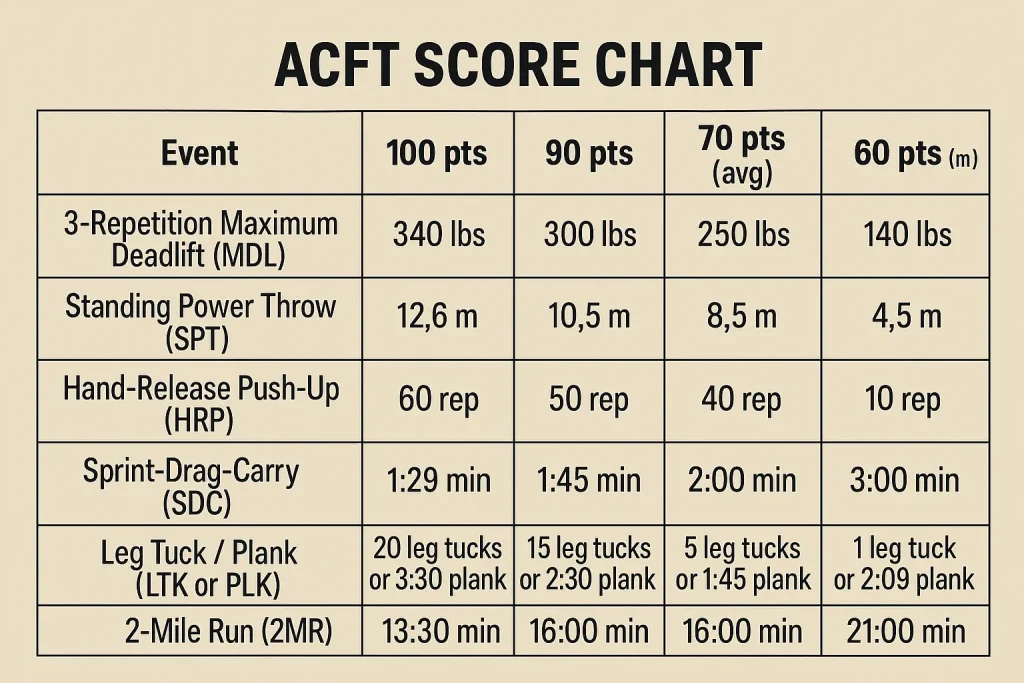
Here’s a more detailed explanation of each of the 6 ACFT events, including how they’re performed, what they test, and scoring considerations:
1 – 3 Repetition Maximum Deadlift (MDL)

What it is:
Lift your maximum weight for three continuous repetitions using a hex bar (trap bar).
How it’s done:
- Stand inside the hex bar with feet shoulder-width apart.
- Grip the handles, keep your back straight, and lift with your legs and hips.
- Perform 3 reps with proper form. The heaviest successful 3-rep lift counts.
What it tests:
- Lower-body strength (glutes, hamstrings, quads)
- Grip strength
- Core stability
Scoring example (male, age 22–26):
- 140 lbs = 60 points
- 340 lbs = 100 points
2 – Standing Power Throw (SPT)
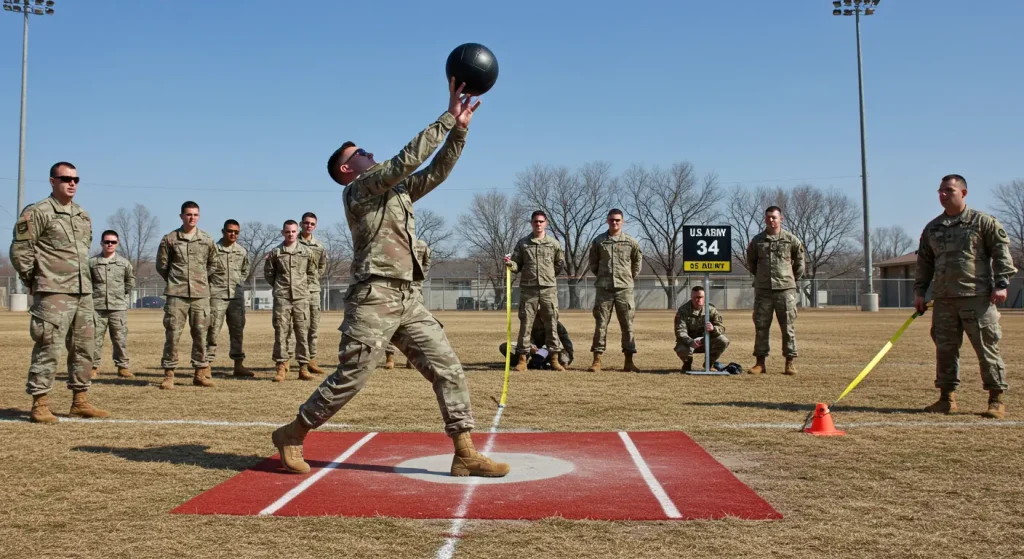
What it is:
Throw a 10-pound medicine ball backward over your head for distance.
How it’s done:
- Stand behind a line facing away from the target.
- In one motion, swing the ball down and up, throwing it backward over your head.
- You get two attempts, and the farthest throw counts.
What it tests:
- Explosive upper and lower body power (hips, core, shoulders)
- Coordination
Scoring example (female, age 27–31):
- 4.5 meters = 60 points
- 10.5+ meters = 100 points
3 – Hand-Release Push-Up (HRP)
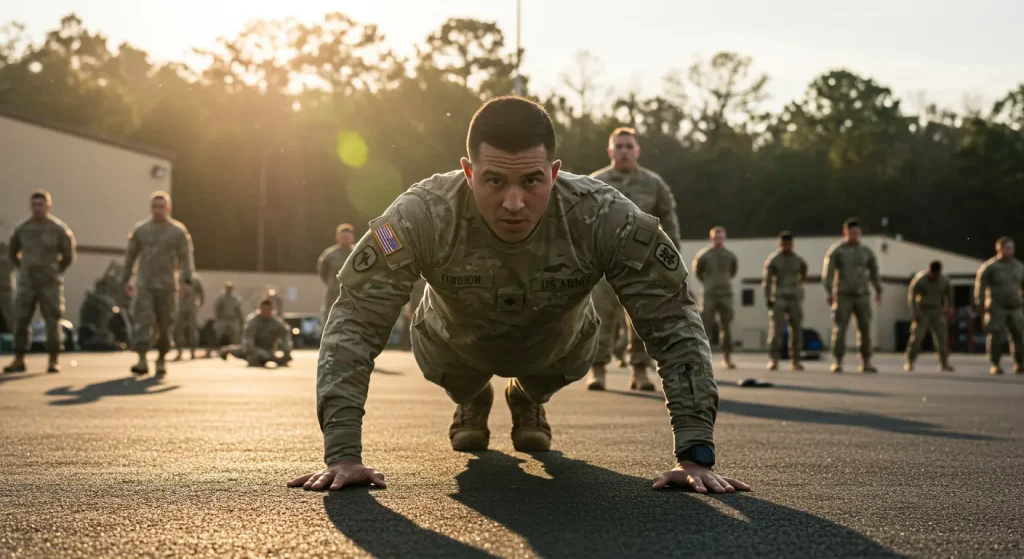
What it is:
Do as many hand-release push-ups as possible in 2 minutes.
How it’s done:
- Begin in the down position (chest on the ground).
- Lift your hands briefly off the ground between reps.
- Push back up to the top, locking elbows.
- Maintain proper form, or reps won’t count.
What it tests:
- Upper-body muscular endurance (chest, shoulders, triceps)
- Core stability
Scoring example (male, age 17–21):
- 10 reps = 60 points
- 60+ reps = 100 points
4 – Sprint-Drag-Carry (SDC)

What it is:
A fast-paced shuttle event that includes sprinting, sled dragging, lateral shuffles, and kettlebell carries.
How it’s done:
- Sprint 25 meters down and back.
- Drag a 90-lb sled 25 meters down and back.
- Perform lateral shuffles down and back.
- Carry two 40-lb kettlebells down and back.
- Final sprint down and back.
What it tests:
- Speed, agility, and muscular endurance
- Anaerobic and functional strength
Scoring example (female, age 32–36):
- 3:00 min = 60 points
- Under 1:33 min = 100 points
5 – Plank (PLK)
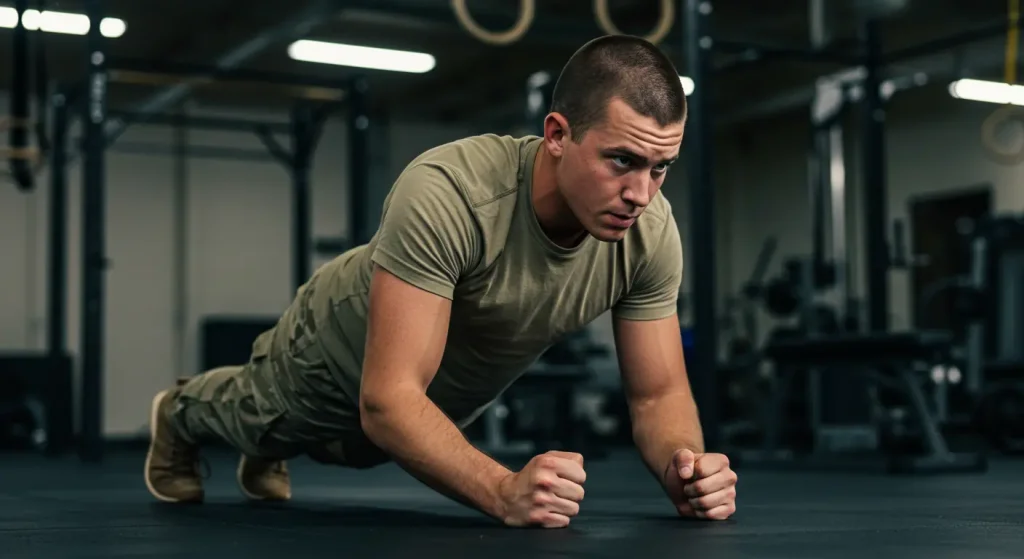
What it is:
Hold a forearm plank position for as long as possible.
How it’s done:
- Elbows directly under shoulders, feet together, back flat.
- Time starts when a position is held and stops when the form breaks.
What it tests:
- Core strength and stability
- Shoulder and spine endurance
Scoring example (all genders):
- 1:30 = 60 points
- 4:20+ = 100 points
(Note: The plank officially replaced the Leg Tuck in 2023 due to feedback about fairness and core strength accuracy.)
6 – Two-Mile Run (2MR)
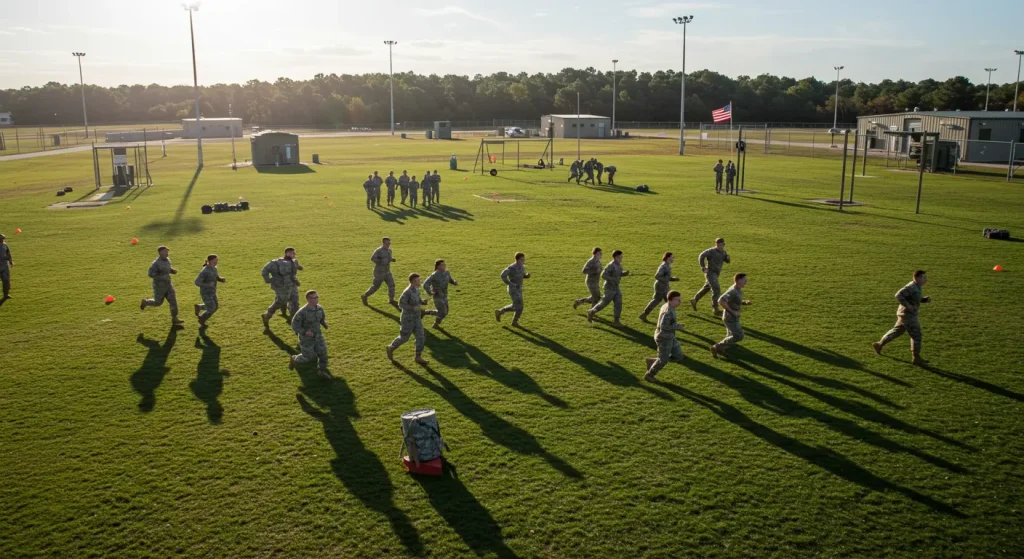
What it is:
Run 2 miles as fast as you can on a flat surface.
How it’s done:
- Completed on a standard track or measured route.
- Requires pacing and stamina to avoid slowing down.
What it tests:
- Cardiovascular endurance
- Mental resilience and pacing
Scoring example (male, age 22–26):
- 21:00 = 60 points
- Under 13:30 = 100 points
According to Army data, over 35% of soldiers initially failed the ACFT during early testing phases, mostly due to the two-mile run.
These events all contribute to your overall fitness. If you’re preparing for the US Army, you have to score at least 60 for each event for a passing score, which is collectively 360. You may fail if you score lower than 60 in any event.
How Can You Improve Your ACFT Score?
Improving your ACFT score takes consistent training, smart recovery, and good habits. Here’s how you can boost your performance across all 6 events:
By consistently following these recommendations and keep checking your performance on the ACFT calculator will keep yourself ahead in training and the Army Combat Test.
1. Train for Each Event Specifically
- Deadlift: Do squats, Romanian deadlifts, and kettlebell swings to build strength.
- Power Throw: Practice medicine ball throws and work on explosive hip and core power.
- Push-Ups: Use pyramid push-up sets and chest/core workouts to increase reps.
- Sprint-Drag-Carry: Do shuttle runs, sled pulls, and kettlebell carries to improve speed and agility.
- Plank: Add planks, side planks, and hanging leg raises to your core routine.
- 2-Mile Run: Run 3–4 times per week; mix long runs, intervals, and sprints.
2. Use Proper Form
- Bad form = failed reps or injury.
- Learn the correct movement for each event (especially for deadlifts and push-ups).
3. Track Your Progress using the ACFT calculator
- Use an ACFT calculator to track scores and see where you need to improve.
- Test yourself monthly to measure progress.
4. Focus on Recovery
- Rest days are just as important as workout days.
- Stretch, hydrate, sleep well, and eat enough protein and carbs to recover.
5. Build Mental Toughness
- Practice pushing through fatigue, especially during the sprint-drag-carry and run.
- Visualize your success and stay consistent even when it gets tough.
6. Join a Training Group
- Working out with others can keep you motivated and help you learn faster.
- Army units often run ACFT-focused training—join in when possible.
